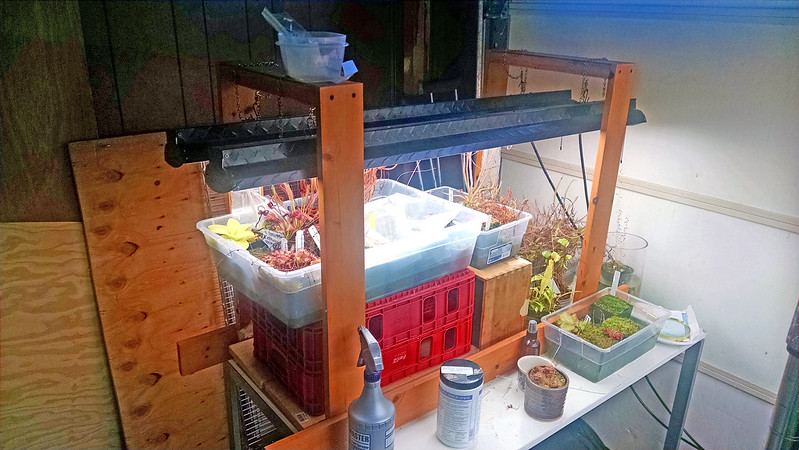Before we get started on the post – check out the ICPS Holiday Seed Bank Drive on Facebook. Have you collected your seed to donate yet? Join the Facebook event for more information! Use the hashtag #ICPSHolidaySeedDrive to share pictures of the seed you're donating.
I've had a few people ask me for pictures of my setup in recent months and I've held off on posting any because it was a real mess. Distilled water jugs and old shipping boxes everywhere, supplies scattered everywhere – it was pretty embarrassing. Yesterday, however, I bit the bullet and tidied it all up, so here we are!
 |
| Home sweet home. |
 |
| The spot on the right is for lower-light plants. |
I grow my sundews, pings, and utrics under lights in my garage. I live in the inner Bay Area, so temperatures are always pretty mild, and even during heat waves there's generally a nice night-time temperature drop in the evenings to the 50s or 60s. My garage is consistently the coolest room in the house during summer, which is good, since pretty much everything I grow looks better when it's cool. I use steel wire shelves from the Home Depot for 2 of my growing areas, and a homemade frame on an old table for the other. There's about 6 sq. feet of growing space under each set of lights.
 |
| My camera did not enjoy taking this photo. |
I use T8 fluorescent bulbs as my light source, using a common shop-light fixture. I covered the reasons for this choice more extensively in my
Cultivation Guide: Light part 2, but the basics are that T8 bulbs are nicely-situated on the efficiency/attractiveness/cost/ease of sourcing matrix. T5s are more efficient, but quite a bit more expensive. LEDs are probably going to be the the obvious choice in the future, but for right now fixtures are expensive, hard to find, and sometimes of dubious use for plants. The main problem with fluoros is that they degrade fairly quickly. I need to replace quite a few bulbs this upcoming year.
My light intensity may be higher than necessary, but this won't hurt the plants. It ends up being about 2500 lumens per square foot of growing space. I could do better if I used reflective material on some of the sides, but that makes it harder to access my plants, which is part of the reason I haven't done so yet. I think anything about 2000 lumens/sq. ft. is probably a very good amount of light.
 |
| Milk crates: natures building blocks. |
To control my lights I use a very
basic analog timer attached to a power strip. As you can see, I've already maxed out this power strip, so if I want to get any more lights out here I'll have to figure something out. I can adjust the photoperiod by moving the pins on the timer. Right now it's at 12 hours per day. I think I'll drop it to 11 soon and then leave it for winter.
 |
| On the plus side, the pygmies are looking great. |
For trays I use Sterilite containers of various sizes. They actually make for a fairly efficient use of space, but there are two main problems. First, as you can see in the above photo, they degrade quite quickly under high UV light. This tray has only been in use for a year and is falling apart. I keep putting off replacing it, and I know I'm going to regret it. The second problem is the trays are significantly taller than the pots I use, which can make it a little less nice trying to look at my plants. I'm still looking around for a better solution. The standard nursery trays aren't a great fit because of the dimensions of my growspaces. We'll see.
The most important aspect of my growing areas is that they are low-maintenance. The garage is great, because I don't have to worry about spilling water or anything like that. I'm also fortunate that I live in a mild, relatively humid climate (usually between 20% and 70% humidity), and I also don't grow any very finicky plants. That's the real trick.
 |
| Apparently Drosera sessilifolia flowers open early in the morning, which is why I never catch them. |
Flowers!






Great to see your whole setup. I'm envious of your nice temperatures. I've got to worry about cooling and heating here. I just did a short video of my new lowland setup at http://ngcarnivorousplants.blogspot.com/2015/12/lowland-plants-new-setup.html. And I've done similar posts about my highland setup (see, e.g. http://ngcarnivorousplants.blogspot.com/2015/11/the-equipment-in-highland-grow-tent.html).
ReplyDeleteI just wanted to let you know that, as far as T8s go, it looks like LED replacement bulbs are really starting to be manufactured for those with some pretty good specs. The bulbs are still expensive ~$20 a piece, but by the time you have to swap bulbs again, you should be able to get some good LEDs without needing to swap out the ballast or anything. I've been trying out some Luxul brand ones for T5HO replacements and they've been doing really well. I'm very pleased, but I wish they were cheaper.
Those Home Depot shelves are the best. I love the adjustability, and they're pretty durable. Plus, it's very easy to hang lights off them.
Everything looks great!
Really enjoyed the overview of your whole setup. Very cool!
ReplyDeleteThat's amazing. What is the temperature aroun the plants in this setup.
ReplyDeleteTemperatures range between mid-80s during the handful of hottest days in summer and high 30s during the coldest couple nights in winter. It's usually more around 70 F during the day in the warmer months, and 50 F during the cooler months. Night time temperatures are usually in the 50s.
Delete